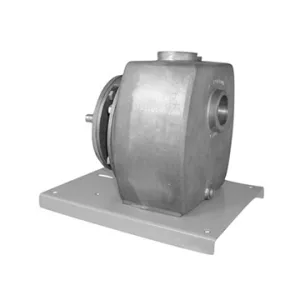
Centrifugal Pump – 75PB
This Oberdorfer centrifugal pump uses a mechanical type shaft seal with a Nitrile rubber element. It is suitable for water, oils, and some mild solvents and it is limited to 212o F. Fluoroelastomer (S10) seals or Polytetrafluoroethylene (PTFE) (S11) seals are available for severe solvents, difficult chemicals, and elevated temperatures. The flow of a centrifugal pump can be conveniently controlled by a throttling valve in the discharge line without the need for a relief valve. In centrifugal pumps, the horsepower demand will decrease as the pressure increases. Maximum horsepower occurs with a wide open discharge.
Features
- Self Priming to 20 Feet Suction Lift
- Heavy Duty Ball Bearings
- Designed for Pulley Drive Applications
- Stainless Steel or Nitrile Shaft (75PB-01)
- Polytetrafluoroethylene (PTFE) Barrier Lip Seal to Protect Motor Bearings
- Carbon Face Mechanical Pump Seals
- Fluoroelastomer (S10) or Polytetrafluoroethylene (PTFE) (S11) Pump Seals Available for Solvent Transfer
- Bronze Models with Nickel Alloy Shaft Ideal for Marine Service (including air conditioning, bilge, and sea water recirculation)
- Will Handle Contaminated Liquids
Performance
- Max Flow: 94 GPM – 355.83 LPM
- Max Pressure: 34.6 PSI – 2.39 BAR
DRIVE
The pedestal centrifugal pumps can be direct driven by electric motors at either 3450 R.P.M. or 1725 R.P.M. Performance for both speeds are shown in the curves above. The 75PB pedestal centrifugal pump can be pulley driven at any desired intermediate speed.
Because of the centrifugal pump impeller and body design, rotation must be as shown in the dimension diagram. Standard factory rotation is clockwise facing the pump shaft. If the pump is driven in the opposite direction it will pump only a very small amount.
LIQUIDS & TEMPERATURES
The special pump alloys used provide corrosion resistance to many liquids including water, water solutions, and a wide range of commercial chemicals. Questions as to the chemical compatibility of special liquids should be referred to the factory. Viscous liquids with a maximum viscosity of 2000 Saybolt Seconds Universal can be pumped. However, when pumping viscous liquids as compared with water, a reduction in flow and pressure occurs and the required horsepower rate increases. Liquids heavier than water require additional horsepower in direct proportion to the increase in specific gravity. Liquids contaminated with small solids or abrasives can be handled, but a reduction in mechanical seal life must be expected.
SUCTION LIFT
Self-priming centrifugal pumps must be primed once at the initial start-up through the priming plug opening at the top of the pump body. On subsequent starts the pump will automatically prime itself and develop a lifting capability of 15 feet or more. The height of the suction lift should be kept to an absolute minimum and the size of the suction pipe should be equal or larger than the pump inlet port. A foot valve with strainer is recommended at the beginning of the suction line. Rotation is clockwise looking from the shaft end. Self-priming centrifugal must be operated with the shaft in the horizontal position.

